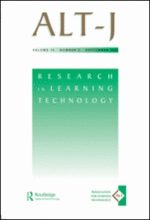The podcast of our contribution to this year IADIS e-Learning conference in Freiburg/Germany is now online. The presentation on „Capture Your University“ has been already published [Link].
[presentation] Capture Your University
Our contribution to this year IADIS e-Learning conference in Freiburg/Germany is about our podcasting/streaming activities. Walther will give today the presentation on „Capture Your University„:
[presentation] Digitale Lernumgebungen an Universitäten
Im Rahmen einer Online Konferenz halt ich heute diese Präsentation über „Digitale Lernumgebungen an Universitäten – Web 2.0, Streaming und mehr?„:
[L3T] GutachterInnen gesucht
 Das Projekt L3T (Lehrbuch für Lernen und Lernen mit Technologien) geht in die nächste Runde. Mit Ende dieser Woche endet die Deadline für die Einreichungen der einzelnen Kapitel und diese sollen nun begutachtet werden.
Das Projekt L3T (Lehrbuch für Lernen und Lernen mit Technologien) geht in die nächste Runde. Mit Ende dieser Woche endet die Deadline für die Einreichungen der einzelnen Kapitel und diese sollen nun begutachtet werden.
Hierzu suchen wir Personen, die Interesse haben aufgrund ihrer Fachexpertise uns zu unterstützen und sich bereit erklären einzelne Kapitel zu reviewen:
[podcast] Has Web 2.0 Reached the Educated Top?
The podcast of our presentation at this year ED-Media Conference in Toronto is now online available. The slides as well as the publication has already been published here.
Member of ALT-J Editorial Board
 I was elected to become a member of the Editorial Board of the ALT-Journal on „Research in Learning Technology, the journal of the Association for Learning Technology“ for the next years.
I was elected to become a member of the Editorial Board of the ALT-Journal on „Research in Learning Technology, the journal of the Association for Learning Technology“ for the next years.
Secondly to let you know that ALT’s Trustees today approved the recommendation from the Research in Learning Technology Editorial Board that you be appointed to join the Editorial Board from 1 May 2010.
Here you can find the latest announcement of the Chief Editor [Link] as well as the official Journal Homepage [Link] [List of Issues].
[podcast] Personal Learning Environment for Higher Education – A First Prototype
The podcast of our presentation at this year ED-Media Conference in Toronto is now online available. The slides as well as the publication has already been published here.
[podcast] RT @twitter ist die Uni auf Facebook? #DigitalUniversity #l3t
Nun ist die Aufzeichnung meines Vortrages am eLearning Tag 2010 an der Universität Innsbruck verfügbar. Die Folien stehen bereits online [Link].
